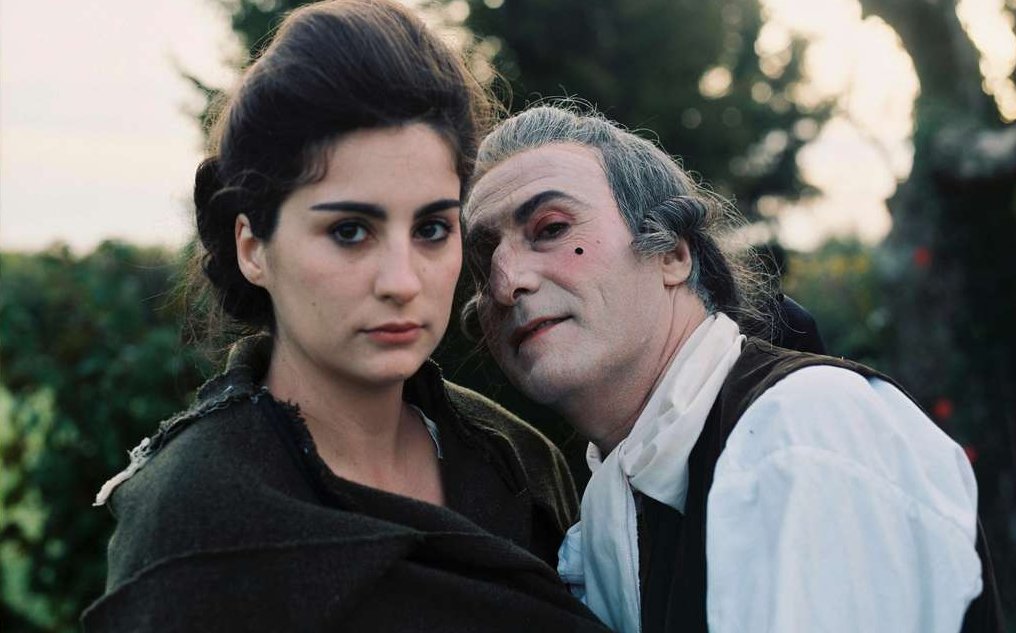Historical fantasy meets art house oddity in Serra’s latest lavish production
Story of My Death availability: GoWatchIt
The curious Story of My Death could have easily been titled “Casanova and the Count,” but that would have provoked notions of a picaresque sitcom. Director Albert Serra opts for the more devious postmodern antithesis to Giacomo Casanova’s famous late eighteenth century autobiography Story of My Life [Histoire de ma vie]. With its wicked sense of humor, Serra’s decadent, slow-moving piece of historical fantasy begins in the opulence of the rolling hills of Switzerland at the aging Casanova (Vicenç Altaió)’s noble château. His pudgy manservant Pompeu (Lluís Serrat) and various diplomats bear witness to Casanova’s pontificating on love and women, maniacal cackling, and gluttonous masticating (a seemingly endless supply of pomegranates and grapes). His patent disregard for anything outside the boundaries of his own ego predicts his downfall but maybe not quite in the way it transpires here in the rude awakening of Dracula.
Initially, Serra is careful not to wholly define any aspect of a plot so that the inertia and “tomfoolery” (as Casanova once mentions) permeate Story of My Death [Història de la meva mort]’s psychology, which is reflected back to the enlightened man of reason. He is repeatedly struck with divine inspiration to devote his life’s mission to the art of writing after sorting through various texts, including those from his friend and rival Voltaire. At a moment’s notice, Casanova’s ambition shifts from historical prophesying and philosophy to the triviality of a dictionary of cheeses. So, yes, any of his meditations on the function of art ultimately fall far from the tree (of life), and the first third of the film revels in the fact that it’s simply a prelude to promiscuity. After the wagon voyage through the South Carpathians to a small Romanian cottage, off-kilter erotica involving three daughters is trounced by an impending chaos of one princely feeding vampire (Eliseu Huertas) oddly lurking in the midday sun.
The aimlessness of both Casanova and the film may work against the lengthy stretches of loquaciousness (in the lesser-known Romance language of Catalan), but it complements the latter half’s innovative interplay of religious and doom-laden gothic imagery that Casanova and Dracula respectively embody. Serra pays homage to classic European art house cinema, from Werner Herzog’s Heart of Glass (1976) and Nosferatu (1979), to Bergman’s Hour of the Wolf (1968) and Peter Greenaway’s The Draughtman’s Contract (1982). A kinship is also found in Alex van Warmerdam’s recent Borgman (2013) in the supernaturally playful malevolence that targets the bourgeois class. With regard to the spoken word, hypnosis of the actors employed in Heart of Glass seems to be a creative reference point, as Serra achieves the strange rhythm of dialogue through a combination of improvisation and achronological editing. This enduring dichotomy instills Story of My Death with tension, its surreal artifice railing against the untouched naturalism of cinematography leaning heavily on natural light. Ivan Čerečina of Australia’s 4:3 Film further hints at this idea of vanishing performances, ones that were mysteriously crafted in post-production, having never happened in the reality of environment, a parallel to the film’s fantastical exoticism in its narrative trajectory. Despite the sedated pacing over its 140 minutes, the situation, stuck between timeless satire and uncanny modern horror concept, possesses an otherworldly energy.
Of course, given Casanova’s eternal reputation as a womanizer, at least a third of Story of My Death is preoccupied with more historically familiar male-driven appetites compared to the enigmatic, meandering tête-à-têtes heard in Casanova’s abode. The three daughters at the Romanian residence, Carmen (Montse Triola), Delfina (Noelia Rodenas), and Clara (Clara Visa), are all gradually defined by their surrender to or resistance of the visiting men. In Serra’s lumbering yet astute approach, there’s something inexplicable in the collapsing worlds of intellectualism and romanticism that frequently isolates the women to obscure their identities. The impression is actually similar to Robert Hillyer Barnett’s currently undistributed Tears of God (2015) and its own quartet of female lookalikes. An opaque, mystic lens towers over shadowy landscapes and narratives of both features; but where Tears of God is centered around menacing theatrical performance, Story of My Death is rooted in an avant-garde gothic literary tradition. In the intercutting of the amorous pomposity of real-life adventurer Casanova and a variation on Bram Stoker’s mythical monster, the end-result is more inconsistent than the set-up may promise. Still, the premise remains invitingly absurd.
–
Be sure to check out other Missed Madison Film Festival reviews throughout the day, including David Klein on The Lobster here at LakeFrontRow.
Jason Fuhrman on Maps to the Stars; Craig Johnson on Experimenter; and James Kreul on Field Niggas at Madison Film Forum.
Four Star Video Podcast‘s discussion of Alléluia.


